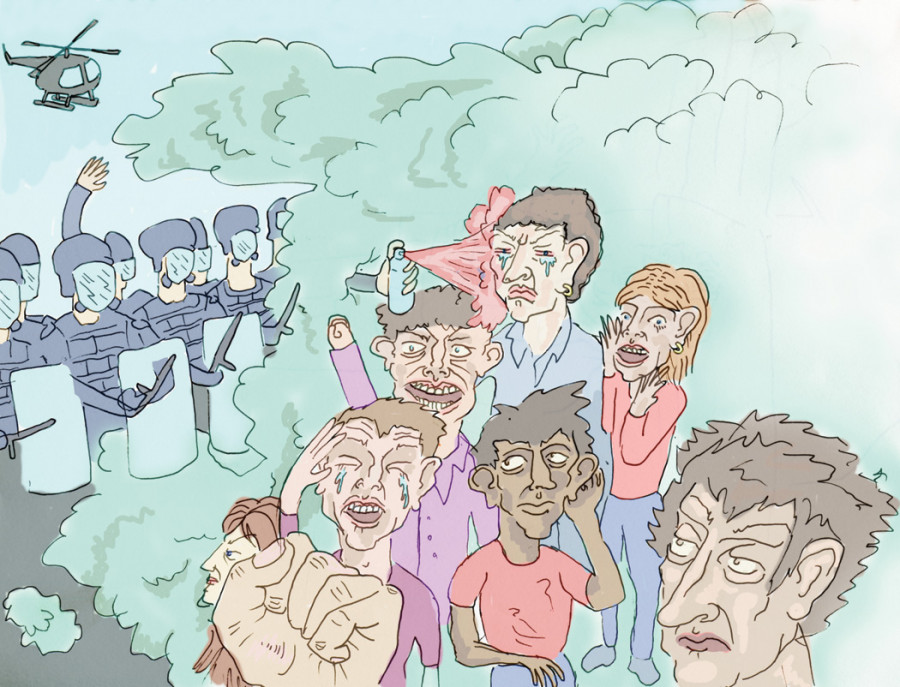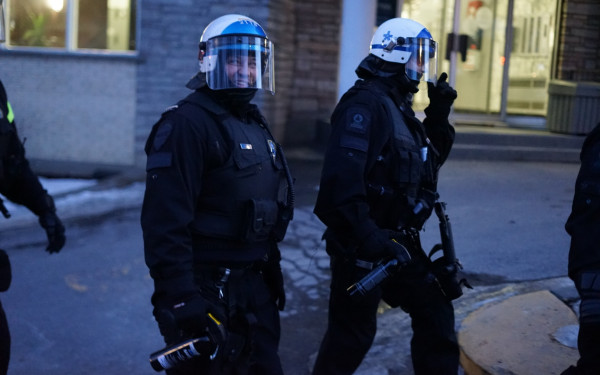Editorial: Police Response to Protests Can Only Galvanize Students
The student protesters who awoke with their ears ringing and eyes reddened will only be galvanized and toughened in their resolve in the fight against austerity.
The SPVM’s impatient, heavy-handed response on Friday can only compel them.
As the cloud of smoke lingers among fleeing protestors, one scrambles to cover their face with a scarf. Choking, coughing violently, scratching eyes and sprinting—these shouldn’t be common adjectives for describing a demo.
The police relied on everything in their non-lethal arsenal on Friday, barely employing neither coercion nor patience. Smoke canisters, noise grenades and tear gas were their methods of persuasion as they sought to enforce the terms of the highly controversial P-6 bylaw.
P-6 was amended during the Maple Spring of 2012, as police sought to force organizers of marches to disclose their demonstration routes. The SPVM, like many other government forces across the globe, have recently incorporated “kettling” tactics, where lines of riot cops converge upon a group of protestors, block them in, and issue tickets en masse. People really hate it, and it’s a fantastic way to at once rile up a crowd and intensely increase civilian resentment of police.
Sure, a small contingent of perhaps fifteen flag-bearing youths attempted to break the police line on St. Alexandre St. and Ste. Catherine St. The vast majority of demonstrators, however, only broke one rule on March 27. And yet, the charging of the police line by a clear minority of protestors was easily used as the police’s catalyst for shutting the whole thing down—violently.
“A qui la rue? A nous la rue!” chanted the protestors in opposition to P-6, which effectively outlaws spontaneous demonstrations.
In early February, judges at the municipal court level threw out thousands of fines accumulated over the past few years under the bylaw. The monumental decision started in a case involving Eric Thibeault Jolin, Patrick René and A.K. (a minor at the time) who were the defendants.
Judge Randall Richmond, who oversaw the proceedings, declared that the trivialization of what constituted a violation of the law was “staggering” and that P-6 was a flawed concept. The main contention was with its feasibility.
Equivalent to a parking ticket, P-6 requires an officer to be a witness to the alleged offense. In a demonstration of hundreds, how can one prove that each demonstrator violated the law?
By demonstrating the right to walk Montreal’s streets Friday and Monday nights, students sent yet another clear message to Coderre, Couillard and the Liberal government that they will accept neither the P-6 bylaw nor austerity.
Police treated the thousands like a herd, banging batons against shields, throwing explosives and chasing people away. Protestors, journalists and bystanders alike were repeatedly harassed.
The response of the SPVM—and who knows the extent to which they act under the express orders of political figures—was almost if not as extreme as the response on Thursday in Quebec City. A student there was hit in the face by a tear gas canister from point blank rage, which was captured on a video that soon went viral.
Who knows if these events will serve as the catalyst for wider protests, with attendance beyond the well-represented 18 to 25-year-old demographic.
If the police continue to use tear gas launchers as weapons, as opposed to crowd dispersal devices, then this will become inevitable. The scare tactics used by the police sent protestors scattering, tears gushing and limbs flailing, but more than anything, it bred discontent.
The SPVM is rapidly losing the hearts and minds of the protestors who were not ardently opposed to their methods (or at least had never encountered them), as a vehement hatred replaces a long-forgotten indifference towards our supposed protectors.
It seems people’s opinions of the police’s tactics fell into two categories: shock and jaded indifference. It is certain, though, that the protests of the coming week will be charged with a climate of anger, injustice and spite. The police themselves, throughout Quebec, are digging themselves a hole this spring by seeking to enforce a bylaw through their own belligerence.
If the neoliberal austerity agenda is the driving force behind the police’s actions, then one wonders how much it costs the city to enforce the P-6 bylaw and maintain militaristic police measures through the almost daily marches.
In 2014 activist Jaggi Singh reported that the city would spend $110,000 plus taxes and fees on lawyers, before policing costs were tallied, just to defend the bylaw.
When one considers that the average hourly rate paid to a police officer was $33.65 in 2013, one begins to wonder how long the city will be prepared to pay in order to stifle the cries and democratic aspirations of students, who will undoubtedly take to the street on Thursday with a renewed impetus.
As the protest withered away at around 11 p.m., a core of protestors were still being held in a kettle on Ste. Catherine St. The ruling of a U.K. High Court that placed heavy restrictions on kettling (which was enforced in 2009 at the G20 protests) shows that it’s high time Quebec deals with its own traditions of police brutality.


_600_832_s.png)




